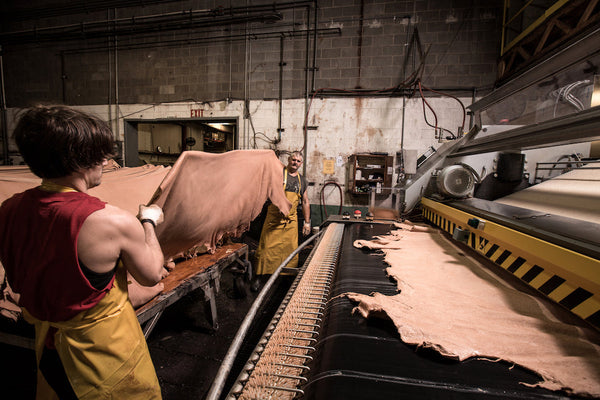The History & Tradition of Vegetable Tanning Leather | Proven Hands
Apr 29, 2025
Why Vegetable Tanning Has Stood the Test of Time
Vegetable tanning leather has been around for thousands of years, a method that’s as old as civilization itself.
It’s a process that’s rooted in tradition, craftsmanship, and quality.
Modern tanneries have adopted faster methods like chrome tanning. But the rich history and durability of vegetable tanning make it the best choice for leather products.
In this article, we’re going to do a deep dive into the history of vegetable tanning leather.

What is Vegetable Tanning?
Vegetable tanning is the process of using plant-based tannins to treat raw hides. These tannins come from the bark, leaves, and fruit of different trees like oak, hemlock, and chestnut.
This method takes longer than chrome tanning but the results don't lie. Leather using vegetable tanning is stronger, supple, and better for the environment.
Ancient Leather Tanning Methods
Early Civilizations: Egyptians, Romans, and Native Americans
Leather crafting dates back to ancient times. Egyptians and Romans used animal hides to create durable goods for everyday life.
These cultures used vegetable-based tannins found in their natural surroundings. The process was slow and labor-intensive, but the leather produced was tough and could withstand the test of time.
In North America, Native Americans used vegetable tanning for making everything from clothing to tools. They extracted tannins from trees like oak and hemlock to create long-lasting leather goods.
How Different Cultures Tanned Leather
In ancient Egypt, tannins from trees like acacia treated hides for sandals, armor, and other goods.
Romans were the first to use oak bark in tanning, resulting in better leather products.
Native Americans focused on animal and plant-based tanning. This created high-quality, durable leather through methods passed down through generations.
Medieval Leather Craftsmanship
By the Middle Ages, leatherworking was an important trade in Europe. Tanneries were usually near forests so that it would be easy to get the resources needed for vegetable tanning.
During the Renaissance, skilled leatherworkers lived in cities like Florence, Venice, and Paris.
These craftsmen honed their skills, making high-quality leather goods. Bags, shoes, and armor were a few of the goods produced.
The Rise of Traditional Tanneries
By the 16th century, vegetable tanning was the standard. These traditional tanneries used large vats to soak the hides in tannin-rich liquids for weeks or months. This let the leather absorb the tannins fully and become resistant to wear and tear.
Leatherworkers were highly respected in these communities. The craftsmanship involved in vegetable tanning was considered an art form. The leather produced in these tanneries was known for its natural look and durability.
The Industrial Revolution & Mass Production
The Industrial Revolution brought about huge changes to the leather industry. With the invention of mass production techniques, many tanneries began shifting to chrome tanning. A faster and cheaper method that could produce leather in a fraction of the time.
While chrome tanning made cost effective leather, it also led to a decline in the quality of leather goods. Unlike vegetable-tanned leather, chrome-tanned leather degrades faster and is less durable.
The Decline of Vegetable Tanning in the 20th Century
By the 20th century, vegetable tanning was on the decline.
The demand for faster, more affordable leather led to the widespread use of chrome tanning. The old-world craftsmanship that once made vegetable tanning so revered, started to fade.
The Revival of Vegetable Tanning
Recently, vegetable tanning has made a comeback. People are starting to turn to high-quality, traditional leather products. These folks value sustainability, durability, and the craftsmanship that goes into each piece.
Unlike chrome-tanned leather, vegetable tanning doesn’t use harmful chemicals. Vegetable tanned leather is a safer option for both the environment and the people who work with it.
As folks become more careful about the products they buy, the demand for traditional leather craftsmanship keeps rising.

Why People Are Returning to Traditional Leather Craftsmanship
People are turning back to vegetable-tanned leather because of their values. They want high-quality, long-lasting products that offer more than just short-term value.
People are starting to catch on that mass production can be harmful and cheap. Vegetable tanning provides a level of craftsmanship and toughness that can’t be matched by chemical-based tanning.
Vegetable tanning stands out because it's real and tough. The leather isn't just strong. It gets better as it ages, developing a one-of-a-kind look. That's why vegetable-tanned leather is the top choice for high-quality leather goods like Proven Hands full grain leather work belts.
Proven Hands & The Tradition of Vegetable Tanning
At Proven Hands, we stick to the old-school way of vegetable tanning because it's tough and built to last. Each of our leather belts is made with this sustainable, durable method.
This is a belt that only gets better with age. As you wear it, the leather softens and develops a rich patina. Shaped by your work, your hands, and your daily grind. No two belts age the same, making yours truly one of a kind.
We craft pieces that honor the tradition of vegetable tanning, a process that’s been passed down for generations. Whether you’re on the job or hanging out with friends, Proven Hands belts are built to last, just like the vegetable tanning method itself.
Carrying the Tradition of Vegetable Tanning
Vegetable tanning is a tradition that’s lasted thousands of years. Many companies have turned to faster, cheaper methods. But the comeback of vegetable tanning shows that quality, craftsmanship, and sustainability still matter.
At Proven Hands, we’re proud to keep that tradition alive. We use premium vegetable tanned leather from Wickett & Craig to craft belts that not only hold up but get better over time.
Explore Proven Hands Full-Grain Vegetable Tanned Leather Belts
Ready to invest in a belt that’ll last? Check out our collection of vegetable-tanned leather belts.
Built to handle hard work, Proven Hands belts are made with the same dedication to quality that’s kept vegetable tanning alive for centuries.




